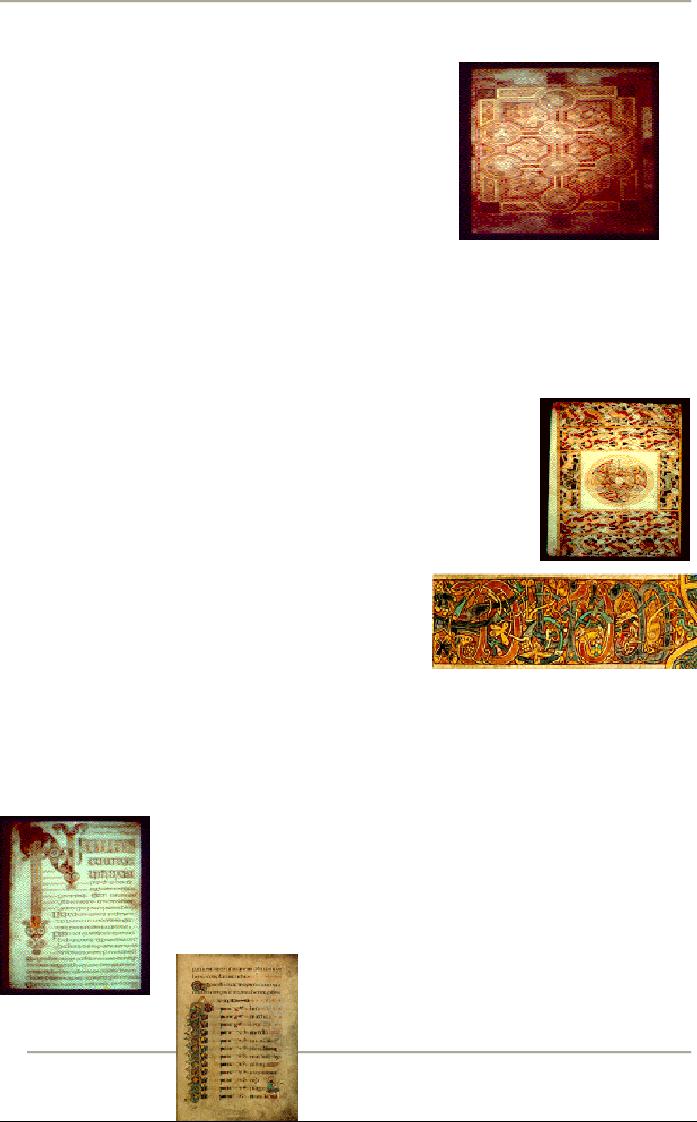 |

Introduction
to Mass Communication MCM
101
VU
LESSON
13
MASS
MEDIA HISTORICAL
PERSPECTIVE
Before we
count on various forms of mass
media and its impact on the
growth of societies and
its
importance
in the contemporary world, it is pertinent to
see in little more detail
how it all began
under
circumstances
which seem difficult to
believe in modern times.
Mankind
has always been interested
in knowing about the physical things
around and the ideas on the
human
life as structured by the intellectuals
of the day. The only problem
was the missing link of
mass
medium
which should work as a conduit to
transport feelings of scholars to
others.
There
is no trace available as how people
from distant territories would exchange
views and information
by
the
sixth century. There is a general
impression that it would
have been through the
travelers and war
expeditions
that might fetch information about
far flung parts of the
world. But traveling was no
easy
business
and in the absence of maps
and knowledge of geography and
routes only few would
dare to
explore
the world and return safely
back to their hometown. Since
recorded history is not
available of those
times
it is left only to our imagination
how mass communication would
have been going around the
civilizations
which were old and developed
enough to assume a shape of an organized
society.
The
availability of languages was
only ample to accomplish the
task of limited scale
inter-personal
communication.
Sending a message to many
was still an enigma.
A
breakthrough was made by the
invention of paper but it
was still far from the
concept of mass
communication.
Books
first fascination towards mass
media
It
is not known as what the first
book was or when exactly it
saw light of the day. Traces
are
available
to say with some certainty
that in the 7th century people had some
idea about books. Though
scant
and
written on very limited topics,
these books can be symbolized as the
pioneer in mass communication as
they
were able, though on a very
limited scale, to carry
message to many others
irrespective of cast,
color,
religion,
rich or poor.
Four
early Periods in the History
of the Books
�
7th
to 13th Century: The
age of religious "manuscript" book
production. Books in this period
are
entirely
constructed by hand, and are
largely religious texts whose creation is
meant as an act of
worship.
�
13th
to 15th Century: The
secularization of book production. Books
are beginning to be produced
that
do not serve as objects of worship,
but that try to explain
something about the
observable
world.
The difficulty with the
spread of such knowledge was
that production is still
taking place via
pre-print
- manuscript - methods.
The
production of secular books is driven by
two things:
The
rise of universities in Europe, spreading
from Italy.
The
return of the crusaders in the 13th
century, who bring with them
texts
from
Byzantium.
These books, written during the
Greek and Roman periods in
history, focus on
this-world
concerns.
�
15th
to 16th Century: The
first printed books. These
are print versions of
traditional works like the
Bible,
books of hours (prayer books) and the
religious calendars.
�
16th
to 17th Century: New
information is put into books
that have important
consequences on
European
life and society.
Book
- from hand-written to
printing
The
7th to the 9th century was the
heyday of the "illuminated manuscript".
Production of these
works
took place in the monasteries
scattered across Europe.
These religious retreats were the
repositories
of
those texts of Greece and
Rome which survived in Europe.
Monks in the monasteries made
copies of
34

Introduction
to Mass Communication MCM
101
VU
the
books in their care - both religious
and secular manuscripts.
However, they did not
contribute much
more
to the advancement of that intellectual
tradition, because they were
not engaged in thinking about
the
relationship
between the works in their care
and the world outside the
monastery.
During
this time, the production of Bibles was
the place where the
arts
of the monastic scribes, and
later lay artists, flowered. It
was here
that
the most elaborate and
beautiful illumination found
its outlet and
the
manuscript books from this period
represent the height of the art
of
decoration.
An
illuminated manuscript is the
Irish
Book of Kells:
The
image shown here is an eight-circle
cross - one of the
central
motifs
of this manuscript, all of which
focus on aspects of Christ's
life and message. According
to historian
Meehan,
the Book
of Kells is the
most lavishly decorated of any
manuscript produced between the 7th
and
9th
centuries.
The
most important thing about the
manuscript books of this period is that
they were objects of religious
veneration.
They were seen as consecrated
objects. Their creation was an
act of religious devotion.
The
monks,
who sat for years,
working on single chapters of the
Bible, were not reproducing books. They
were
making
the word of God manifest in the
world.
This
is the "carpet page" from the Book
of Durrow,
created around 680 A.D.
The
woven
pattern on this page is called
"interlace" and exhibits both
zoomorphic and
abstract
elements in its
design.
The
detail of interlace in the Book
of Durrow is
more refined by the time the
illuminators
get to the creation of the Book
of Kells. In the
Book
of Durrow,
the
interlace
covers the page, in the Book
of Kells, it
becomes part of larger
images.
In
this detail from the Book
of Kells, showing the
heads of lions
and
chalices spouting vines, we can
more clearly see the
zoomorphic
aspects of interlace.
However,
in interlacing, the interweaving of the bodies of
snakes
and
lions, of peacock and fishes,
chalices and vines, is
not
intended
to be a naturalistic representation of the existing
world. These images are
schematic and
symbolic.
The
images are meant to
represent some aspect of
Christ's life.
We
think of modern books as being illustrated, but the
illustration and photographs, the images,
are usually
distinct
from the text. In these
early manuscripts dedicated to
God, the two were not so
separate.
Book
of Durrow
First
page of Saint Jerome's translation of the
four gospels into
Vulgate.
Book
of Kells
First
page of a genealogy
of
Christ
35

Introduction
to Mass Communication MCM
101
VU
If
you look carefully at these pages, you can see
that the decoration is carried
into the text. There is
continuity between the
words
and
the decoration, a continuity that
suggests that the illuminated religious
manuscript is an attempt to convey the
beauty of
God's
message to mankind.
Early
analysis on manuscripts
For
all their beauty, as mentioned above, the
manuscripts of the monasteries did
little to affect life
in
Europe. Primarily this comes
about as a consequence of the
inaccessibility of the monastic
libraries.
Instead
of books being openly available as they
are today, manuscript books
were mostly locked up in
monasteries
strewn across Europe. Given
the amount of time and energy and
financial resources that went
into
their production, books were
far too valuable to make
available to the general public. So
there was no
way
to use them for scholarship,
even the few secular texts
that may have been
available.
This
problem was compounded by the lack of a
uniform cataloging system in the
monasteries. So, even
if
one
did have access to the
library of a monastery, there
was no way of knowing what
was in the collection,
or
where it might be
located.
The
period between the 13th and
16th centuries saw the rise
of a print-dominated society, one
that moved
away
from the Church's monopoly of
information that existed
during the manuscript book
period. This was
initially
fueled by the reproduction of classic
texts of antiquity. It was
further fueled by the development of
new
kinds of books in science. These factors
led to the development of books as elements of
propaganda
and
religious education. This is not to
argue that print drove
all those changes. Clearly
it did not. There
were
social
and political and economic
changes that made print
important. Those changes
might not have
happened
as quickly or perhaps at all
without print.
The
shift in consciousness that
occurred with this period of
history is the rise of the notion
that reality
could
be represented. This period saw the
advent and expansion of a European-dominated
world economy
and
the beginning of a system of international
competition for trade among
independent states.
The
technology of the printing press, coupled
with the surrounding changes in the
political/economic
system,
wrought changes in the ways in
which Europe saw its
place in the world.
Ancient
history of printing
The
original method of printing was
block printing, pressing
sheets of paper into
individually
carved
wooden blocks. It is believed that block
printing originated in China, and the
earliest known
printed
text,
the Diamond
Sutra (a Buddhist
scripture, was printed in China in
868 A.D.)
The
technique was also known in
Europe, where it was mostly
used to print Bibles.
Because of the
difficulties
inherent in carving massive quantities of
minute text for every
block, and given the levels
of
peasant
illiteracy at the time, texts such as the
"Pauper's Bibles" emphasized
illustrations and used
words
sparsely.
As a new block had to be
carved for each page,
printing different books was an
incredibly time
consuming
activity.
Moveable
clay and metal type are
processes much more
efficient than hand copying. The use of
movable
type
in printing was invented in
1041 AD by Bi Sheng in China. Bi
used clay type, which
broke easily, but
eventually
Goryeo (Korea) sponsored the production
of metal type (a type foundry was
established by the
Korean
government in the early 15th century).
Since there are thousands of
Chinese characters
(Koreans
also
used Chinese characters in literature),
the benefit of the technique is not as
apparent as with
alphabetic
based
languages.
Movable
type did spur, however, additional
scholarly pursuits in China and
facilitated more creative
modes
of
printing. Nevertheless, movable type was
never extensively used in China
until the European style
printing
press was introduced.
36

Introduction
to Mass Communication MCM
101
VU
From
China to Germany
Although
probably unaware of the Chinese/Korean
printing methods (with
substantial evidence
for
both sides of argument),
Gutenberg refined the technique with the
first widespread use of movable
type,
where
the characters are separate
parts that are inserted to
make the text. Gutenberg is
also credited with
the
first use of an oil-based
ink, and using "rag"
paper introduced into Europe
from China by way of
Muslims,
who had a paper mill in
operation in Baghdad as early as
794. Before inventing the printing
press
in
1440s, Gutenberg had worked
as a goldsmith. Without a doubt, the
skills and knowledge of metals
that
he
learned as a craftsman were
crucial to the later invention of the
press.
The
claim that Gutenberg
introduced or invented the printing
press in Europe is not
accepted by all. The
other
candidate advanced is the Dutchman
Laurens Janszoon
Coster.
37
Table of Contents:
- MASS COMMUNICATION – AN OVERVIEW:Relationships, Power
- EARLY MASS COMMUNICATION AND PRINTING TECHNOLOGY
- SEVEN CENTURIES OF MASS COMMUNICATION – FROM PRINTING TO COMPUTER
- ELEMENTS OF COMMUNICATION AND EARLY COMMUNICATION MODELS
- COMMUNICATION MODELS – GRAPHIC PRESENTATION OF COMPLEX ISSUES
- TYPES AND FORMS OF COMMUNICATION:Inter personal, Combination
- MESSAGE – ROOT OF COMMUNICATION I:VERBAL MESSAGE, Static Evaluation
- MESSAGE – ROOT OF COMMUNICATION II:Conflicts, Brevity of Message
- EFFECTS OF COMMUNICATION:Helping Out Others, Relaxation
- COMMUNICATION AND CULTURE:Enculturation, Acculturation
- LANGUAGE IN COMMUNICATION:Polarization, Labeling, Static meanings
- STEREOTYPING – A TYPICAL HURDLE IN MASS COMMUNICATION:Stereotype Groups
- MASS MEDIA – HISTORICAL PERSPECTIVE:Early analysis on manuscripts
- EMERGENCE OF PRINT MEDIA AROUND THE WORLD:Colonial journalism
- TELEGRAPH DOES MIRACLE IN DISTANCE COMMUNICATION TELEX AND TELEPHONE ENTHRALL PRINT COMMUNICATION
- TYPES OF PRINT MEDIA:Newspapers, Magazines, Books
- PRESS FREEDOM, LAWS AND ETHICS – NEW DEBATE RAGING STILL HARD
- INDUSTRIALIZATION OF PRINT PROCESSES:Lithography, Offset printing
- EFFECTS OF PRINT MEDIA ON SOCIETY:Economic ideas, Politics
- ADVERTISING – HAND IN HAND WITH MEDIA:Historical background
- RENAISSANCE AND SCIENTIFIC REVOLUTION: ROLE OF PRINT MEDIA:Science
- RECAP:Elements of communication, Books, Printing, Verbal Message
- MEDIA MANAGEMENT:Division, Business section, Press
- IMAGES IN MASS COMMUNICATION – INVENTION OF PHOTOGRAPHY:Portrait photography
- MOTION PICTURES – A NEW WAY IN MASS COMMUNICATION-I:Definition
- MOTION PICTURES – A NEW WAY IN MASS COMMUNICATION (Cont...):Post-Studio Era
- FILM MEDIA IN SUBCONTINENT AND PAKISTAN-I:Accusations of plagiarism
- FILM MEDIA IN SUBCONTINENT AND PAKISTAN (II) & ITS EFFECTS:First Color film
- PROPAGANDA:Types in another manner, Propaganda in revolutions
- RADIO – A BREAKTHROUGH IN MASS COMMUNICATION:What to broadcast
- EFFECTS OF RADIO ON SOCIETY:Entertainment, Information, Jobs
- TELEVISION – A NEW DIMENSION IN MASS COMMUNICATION:Early Discoveries
- TV IN PAKISTAN:Enthusiasm, Live Broadcast, PTV goes colored
- EFFECTS OF TELEVISION ON SOCIETY:Seeing is believing, Fashion
- PUBLIC RELATIONS AND MASS COMMUNICATION - I:History, Case Study
- PUBLIC RELATIONS AND MASS COMMUNICATION - II:Audience targeting
- ADVERTISING BEYOND PRINT MEDIA:Covert advertising
- IMPACT OF ADVERTISING:Trial, Continuity, Brand Switching, Market Share
- MEDIA THEORIES:Libertarian Theory, Social Responsibility Theory
- NEW MEDIA IN MASS COMMUNICATION:Technology forcing changes
- GLOBALIZATION OF MEDIA:Media and consumerism, Media centralization
- MEDIA MERGENCE:Radio, TV mergence, Economic reasons
- MASS MEDIA IN PRESENT AGE:Magazine, Radio, TV
- CRITICISM ON MEDIA:Sensationalize, Biasness, Private life, obscenity
- RECAP:Legends of South Asian Film Industry, Radio, Television, PTV goes colored